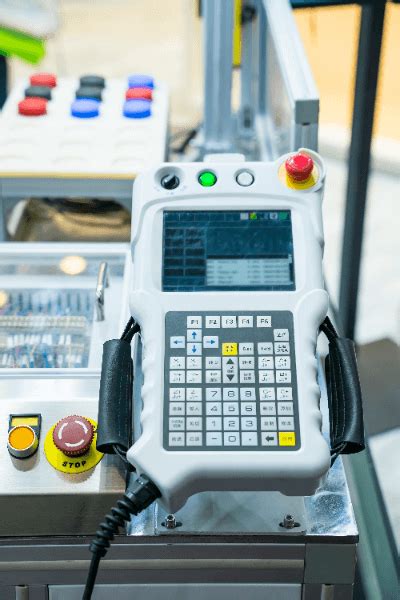The Maestro Behind Industrial Symphony: Unlocking the Power of Robot Controllers
The relentless march of technology has ushered in an era where robots have become indispensable partners in the industrial landscape. At the heart of these automated marvels lies a sophisticated brainstem known as the robot controller. It's the maestro orchestrating every move, transforming raw commands into precise actions, and ensuring seamless integration within complex manufacturing environments.
The Essence of Control
A robot controller is the central nervous system of an industrial robot, responsible for coordinating its motions, processing sensory data, and ensuring its responsiveness to external stimuli. It's the bridge between the human operator and the machine, interpreting instructions and translating them into a language the robot can understand. Without a controller, robots would be mere hulks of metal, devoid of the ability to perform the intricate tasks that define their purpose.
Evolution of Controller Technology
Early robot controllers relied on discrete logic systems, a primitive approach that lacked the flexibility and speed demanded by modern industrial applications. The advent of microprocessors brought about a paradigm shift, enabling the development of powerful controllers with real-time processing capabilities. Today's controllers leverage advanced algorithms, sophisticated software, and high-speed communication networks to achieve unparalleled levels of precision and efficiency.

Types of Robot Controllers
The world of robot controllers is vast and diverse, each type tailored to specific applications. Among the most common are:
-
Dedicated Controllers: Designed for specific robot models, these controllers offer maximum integration but limited flexibility.
-
Open Controllers: Compatible with a wide range of robots, they provide greater versatility but may require additional configuration.
-
PC-Based Controllers: Running on standard personal computers, these controllers offer the highest level of flexibility and customization.
Key Components of a Robot Controller
A typical robot controller comprises several essential components, including:
-
Processor: The brains of the controller, responsible for executing instructions and managing data.
-
Memory: Stores programs, data, and operating system.
-
Input/Output (I/O) Modules: Interfaces with sensors, actuators, and other devices.
-
Communication Ports: Connects the controller to external networks and devices.
The Importance of Robot Controllers
The importance of robot controllers cannot be overstated. They play a critical role in:
-
Precision: Ensuring accurate and repeatable movement of robots.
-
Safety: Implementing safety protocols to prevent accidents and protect humans.
-
Efficiency: Optimizing robot performance to maximize productivity.
-
Flexibility: Enabling robots to adapt to changing production requirements.
Benefits of Advanced Robot Controllers
Investing in advanced robot controllers offers numerous benefits, including:
-
Increased Productivity: By optimizing robot performance and minimizing downtime.
-
Improved Quality: Through precise control and consistent operation.
-
Reduced Costs: By increasing efficiency and reducing maintenance expenses.
-
Enhanced Safety: With advanced safety features and improved operator control.
Common Mistakes to Avoid
When selecting and implementing robot controllers, it's crucial to avoid common mistakes, such as:
-
Underestimating the Complexity: Controllers are sophisticated devices that require expert installation and configuration.
-
Ignoring Safety Protocols: Failure to implement proper safety measures can lead to accidents and liability issues.
-
Overlooking Maintenance: Regular maintenance is essential to ensure optimal controller performance and extend its lifespan.
Advanced Features to Look For
In today's competitive market, advanced robot controllers offer a range of innovative features, including:

-
Motion Control Algorithms: Advanced algorithms optimize robot movements for speed, accuracy, and safety.
-
Predictive Maintenance: Features predict potential failures and schedule maintenance accordingly.
-
Remote Monitoring: Allows remote access and monitoring of controllers and robots.
Pros and Cons of Different Controller Types
When choosing a robot controller, carefully consider the pros and cons of each type:
| Controller Type |
Pros |
Cons |
| Dedicated Controllers |
Optimized for specific robots |
Limited flexibility |
| Open Controllers |
Compatible with multiple robots |
Requires more configuration |
| PC-Based Controllers |
High flexibility and customization |
May be less reliable |
Frequently Asked Questions
1. How much does a robot controller cost?
The cost of a robot controller varies widely depending on its type, features, and brand. Prices can range from a few thousand dollars to over $100,000.
2. How to choose the right robot controller?
The best robot controller for your application depends on several factors, including the type of robot, the desired level of performance, and the budget. It's recommended to consult with experts to determine the most suitable option.
3. How to maintain a robot controller?
Regular maintenance is crucial to ensure optimal controller performance and extend its lifespan. Maintenance tasks may include cleaning, software updates, and hardware inspections.
Humorous Stories to Learn From
Story 1: A maintenance engineer mistakenly swapped the control cables of two robots. One robot was programmed to pour molten steel into molds, while the other was tasked with assembling delicate electronic components. The resulting chaos was both comical and costly.
Lesson Learned: Always double-check connections before operating robots.

Story 2: A programmer accidentally mistyped a single digit in the controller software. Instead of instructing the robot to move 10 centimeters, it moved 1,000 centimeters, crashing into a wall.
Lesson Learned: Pay meticulous attention to detail when programming robots.
Story 3: A supervisor noticed that a robot was moving erratically. After troubleshooting, he discovered that a mischievous employee had attached a remote control to the robot and was playing with it during his lunch break.
Lesson Learned: Establish clear guidelines and supervision to prevent unauthorized access and misuse of robots.
Call to Action
If you're looking to unlock the full potential of your industrial robots, investing in a high-quality robot controller is a wise decision. Contact a reputable supplier today and discover how the right controller can revolutionize your manufacturing operations.
